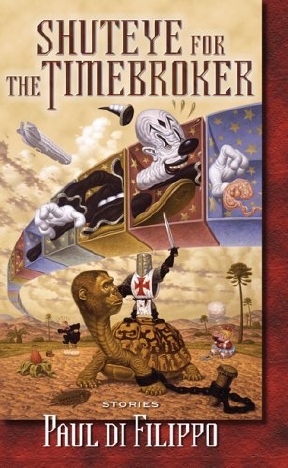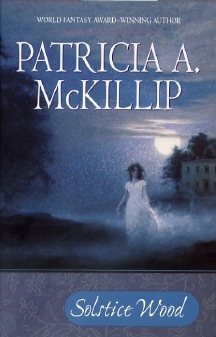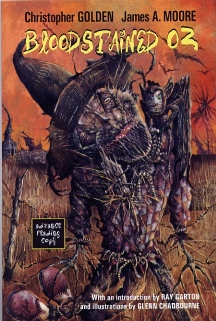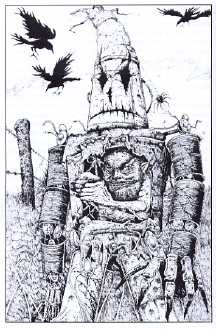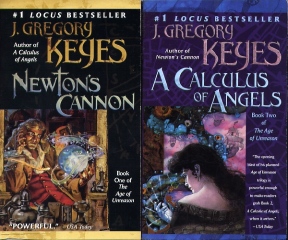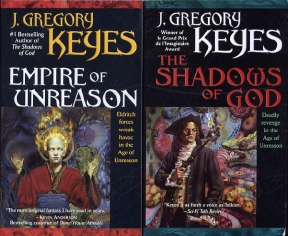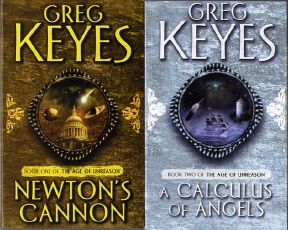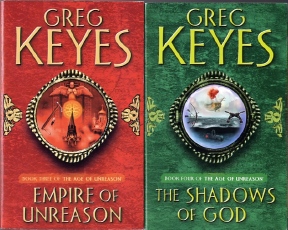|
|
|
This Just In...News from the Agony Column
|
03-03-06: 'The Fix' From TTA and 'Shuteye for the Timebroker' by Paul Di Filippo |
||||||
Short
Fiction Short-Circuits the Publishing Giants
But all this talk hinges on the novel. And for the novel you have raft of reviewing options, from the wonderful Emerald City to the more expected outlets in monthly SF magazines, to your local newspapers (buy them, subscribe to them, read them and please keep them in business!). If you're really obsessed or just a publishing geek-type, you've got Publisher's Weekly. So the cycle goes; annual book, monthly / weekly / daily reviews. Sunrise, sunset -- swiftly go the years. Until all this comes to a juddering halt in the world of short fiction, where you can throw the schedule right out the window. Especially in the SF realm, where short fiction gets published in great quantity and quality. Fantasy & Science Fiction, Interzone, Weird Tales, Fantasy, Analog, Isaac Asimov's Science Fiction Magazine, The Third Alternative and Crimezone and the now-departed but much missed online venue SciFiction -- all of them offer a huge variety of top-notch short fiction. And this doesn't even scratch the surface of the wonderful online short-fiction venues. The publishing schedules tend to be monthly, though the online venues will mutz with that idea, as will some of the UK magazines. But the bottom line is that the pace is fierce, and the short fiction review outlets -- what short fiction review outlets? Well, Andy Cox over at Interzone is about to put The Fix back in operation. The Fix is a review outlet dedicated to short fiction and Andy is cranking it up again in a big way. Currently, he's established a mailing list over on the more-than-slightly-evil Yahoo! Groups for a batch of seasoned reviewers, and there's a lot of interest amongst these reviewers at firing up The Fix. The net effect is that there will be a reviewing venue out for the mass of short fiction out there, dedicated to that short fiction. As I hear more about The Fix, I'll pass it on to you. The TTA website shows the last hardcopy issue as number 8; but with the speed of release and the quick aging, I can't imagine that The Fix won't have a more web-based presence in the future.
'Shuteye for the Timebroker', from title to cover, from cover to cover, is a classic-style collection of short fiction that really harkens back to the good ol' days, when I used to buy the Ballantine collections of stories by genre giant Frederick Pohl. Somewhere out there, I hope there's a ten, eleven-year-old kid waiting breathlessly for every trade paperback release from Di Filippo. There's got to be! This kid is being set up for a life of thought-crime by a master of the art form. Di Filippo's latest collection is, as usual all over the map, and it's this insistence of Di Filippo's --and the willingness of Thunder's Mouth to publish it -- that I just love. Of course, one of the great things about them ol' books, as opposed to them ol' magazines, is that single-author book editors have the opportunity to be a lot more inclusive than their periodical counterparts. So in 'Shuteye for the Timebroker', we get two more Di Filippo stories that we've not had the pleasure of seeing, trunk gems that never made it to the surface back in the day but certainly deserved to. In retrospect, that is, in hindsight where everything is perfectly clear. The publishing world has been engaging in quite a bit of hindsight of late. It's not been pretty, for the most part, but here's an example where it is indeed gorgeous. 'Shuteye for the Timebroker' gives us two, yes two more stories in Di Filippo's entertaining Blackwood Beach stories. You should know the setup here; many an author has mined this sort of territory with great success. So, the shtick is that Di Filippo has created Blackwood Beach, the traditional New England seaside city where, not to put too fine a point upon it, weird shit happens. The Blackwood Beach stories follow a seasonal structure, perhaps by accident or perhaps by design. The answer is lost in the depths of Di Filippo's intro-writing mind. "Captain Jill" gives us a winter warlock. "Billy Budd" gives us a Hollowood story of spring, and reflects an admirable Melville obsession on the part of the author. Of course my reaction as a novel-clutching dweeb is: "Where's the Blackwood novel, Paul?" If there's one in that so-called Cave of Memories, I'm hoping that you'll track it down and carry it posthaste to the good folks at Thunder's Mouth. Then perhaps, in the fullness of time, that kid reading this collection can write his short story about the adaptation of your novel. But of course, 'Shuteye for the Timebroker' is much more than two uncollected stories. There are fifteen stories total, including a really wonderful batch of short-shorts based on the work of artist Todd Schorr titled "The Farthest Schorr". It's pretty interesting to think of the horror-ish "Underground" first appearing in the hardcopy bOING bOING back in 1991, when the web itself was still a twinkle in Tim Berners-Lee's eye. Here's what you can count on in a Di Filippo collection. A) Quality. Excellent prose skills, tight plotting and imaginative writing. B) Variety. Di Filippo can't be cornered or easily quantified. SF, so-called "Dark fantasy", speculative fiction, literary speculations, literary experimentation, really oddball stuff -- you name it, you find it here. C) Great single-paragraph introductions. Do yourself a favor and don’t read them all before reading the stories. So yes, short fiction has a shorter life than long fiction. The release cycle is brutal, getting it published is beyond brutal, and actually being the publisher and trying to sell magazines, short fiction collections or even more mind-bogglingly short fiction review magazines is a couple of quantum universes to the left, right, above and below brutal. But these are the seeds that keep the world of speculative fiction so fresh, so smart, so open. You'd best pay attention, folks, here's the next generation. And here’s what that kid out there, that iconic ten-year-old kid, is reading. He's smart, just like you. We're the past and present. He's the future. |
|
03-02-06: Harry Bruinius is 'Better for All the World' |
||||||
History
As Dystopian SF
Except, of course, when it is history. There's lots of backstory to this world that, were it not real, would have been invented by some science fiction writer. Some of it would seem patently absurd, over-the-top horrific and weird were it not true. Harry Bruinius delves into one such corner of human history, something that is so unpleasant it's hard to imagine let alone write about. But the same era that gave us the Spiritualists also gave us the Eugenics movement. It was all about breeding. In 'Better For All The World: The Secret History of Forced Sterilization and America's Quest for Racial Purity' (Alfred A. Knopf ; February 27, 2006 ; $30.00), Bruinius writes about the history of the American Eugenics movement, which played a key part in Jeffrey Ford's most recent novel 'The Girl in the Glass'. Bruinius once again proves that no matter how twisted, how fertile our imaginations may be, there's always some bit of hidden history out there waiting to demonstrate that science fiction can seem pretty tame when stacked up against reality. And the reality we're talking about it, the so-called (by me) hidden history is not any great secret. It was the stuff of Supreme Court decisions. The title of the book is from the speech made by no less a do-gooder than Oliver Wendell Holmes; "It is better for all the world, if instead of waiting to execute degenerate offspring for crime or to let them starve for their imbecility, society can prevent those who are manifestly unfit from continuing their kind. The principle that sustains compulsory vaccination is broad enough to cover cutting the Fallopian tubes..." One might reasonably ask if this is current events or recent history, when it is neither. Still, the issues that are the motor behind the concept of forced sterilization are at play in society today. They wear a different mask, but the face behind the mask is the same. It's an us-or-them world.
Part of the joy of reading this book is the sharp vision it offers us of a society accepting without question science that justifies racism. It's extremely creepy to read about brilliant men and women subscribing whole-heartedly, enthusiastically to the same logic that Hitler employed during WW II. So when I suggest that science fiction is often part of history, here’s the perfect example. 'Better For All the World' is a gripping vision of science twisted out of true. It reads almost like alternate history because it's not the sort of thing that you’re going to do a unit on in high school. And it's just so insane, so distasteful to our modern sensibilities that it seems almost unreal, like something out of a horror movie. And in fact, many horror movies have been based on this motif. For the general reader, you've got a gripping, if terrifying and sometimes distasteful, portrait of America. For the science fiction reader, you've got mad science at large in American society. For the horror reader, well -- you've got horror and plenty of it. What makes it all so compelling is the utter plausibility of the thought behind the science, the bland and amazingly widespread acceptance of the ideas. Up until we were forced to see ourselves in the fractured mirror of the Nazi drive to create a "master race". Then it all stopped looking like such a good plan. Readers who might want to write science fiction, or just read it, would be well-served by this bit of historical non-fiction. Sometimes you can put utterly, totally incredible ideas on stage and on the page in such a manner as to make them come alive. 'Bruinius does so for eugenics, a term you’re not likely to hear in reference to "genetic engineering". Knopf has done a nice job with this book, filling it with illustrations of the detritus from this era. From Francis Galton trying to make a beauty map of the British isles to eugenics reborn as genetic engineering, 'Better for All the World' gets to the root of some discomforting ideas. Yes, we can make things better. So long as we are leery of those who propose to do so. |
|
03-01-06: Patricia A. McKillip Explores 'Solstice Wood' |
|||
New
Worlds, New Artists and Reverse Infections
One of the things I also looked forward to was the latest work from Kinuko Y. Craft, whose covers for McKillip could easily take over a New York Gallery. (For all I know, they may already have done so. Let's check Craft's website....) OK, well, actually they're showing in -- and this is so appropriate -- Kanazawa, Japan. Craft has an exhibition of "over 25 works of Fantasy and Fairy Tale art" showing at the 21st Century Museum of Contemporary Art, in a show titled "A Spring Night's Dream" running, April 4 through May 14. So, if you happen to be visiting Kanazawa, Japan during those dates, you can feast your eyes on Craft's gorgeous work, and I bet, at least a couple of McKillip covers in the bargain. Those paintings only hint at the wonders McKillip offers, though those hints are themselves pretty damn glorious wonders. So, yes, to my mind, Craft and McKillip were sort of joined at the hip, at least until this, McKillip's latest. I enjoy Gary Blythe's work for 'Solstice Wood'. It's a fine evocative painting. But it's not the Craft half of the pairing. But then, perhaps that's because the McKillip novel isn’t the McKillip novel we've been expecting either. That's what I mean about the single-delta rule. You know, only changing one thing at a time? If McKillip is going to move off-message --a move I welcome -- the least Ace could do is to keep up the Craft/McKillip pairing. I mean, look folks. We're readers, our minds are very small, right? You give us say, ten years of McKillip/Craft novels and covers, all consistently great, all very consistent in terms of content and beauty, then you change not just one, but both? I feel like I got hit by a rock or something! As far as being hit by a rock, well, this is not a bad rock to be hit with. It is, after all, a new Patricia A. McKillip novel and by new, I'm not just referring to the content but also the subject. Because this is the first McKillip novel I've seen that is set in the contemporary world with contemporary characters. That's the windup...here's the pitch. Sylvia Lynn owns a bookstore. Of course she owns a bookstore! What strong-willed woman character in a contemporary fantasy novel would not own a bookstore? Not surprisingly, that bookstore is in San Francisco. Given the current state of independent bookstores in San Francisco, she's probably financially on the ropes, and thus, not unhappy to hear from Gram. Alas, Gram has called with unhappy news; Grampa has passed and Gram wants Sylvia to come visit. Gram's spry and the woods behind the house are well, woody. Gee, do you think the Fiber Guild, a local group of women who meet to sew and chat have something to talk about beyond the latest drop-stitch tech? So it happens, two deltas, two deltas in one! McKillip has finally offered us her own gorgeous surreal concepts grafted into our world. I'm stoked, as I think this is something that might bring her a much larger and very well-deserved audience. But more importantly, I think that McKillip's gentle infusion of fantasy will really bring both our world and her fantasy to life. And now the new cover style makes a bit more sense. While I don’t think that McKillip pursued this story with any particular goal in mind beyond telling a good story, if I were her publisher, I'd be rubbing my hands with glee. Take another look at the cover. Looks pretty romance-like, right? And what more could a publisher desire than a fantasy romance written by one of the best writers the genre has hidden for so many years. McKillip is a one-woman explosion waiting to happen. She has a backlist to die for, especially if you first discover her fiction with this novel. Ace lists twelve other titles in the front page. McKillip is practically an imprint unto herself! What makes this all such good news is that love or hate it -- and a quick glance at the general tilt of what’s out there will more likely lead towards the latter feeling -- romance is big business right now. Well, it's always been Big Biz, but now it's Big Genre Biz, with Tor's Paranormal Romance imprint and Harlequin doing fantasy novels. So amidst the vast morass of reading-as-sub-for-TV bilge (and reading is always better than TV), this island of utterly pure quality could become a sort of reverse infection. Imagine quality spreading outward, ripples of intelligent, well-considered writing achieving mass popularity because it's great writing! The mind boggles and I guess, I guess -- I'm willing to give this whole two-delta thing a slide. This time. But when McKillip returns to the fantasy work that her readers expect, and that can happen sooner or later, we're patient -- we'll want those Kinuko Y. Craft covers back, and Ace, should you have a problem ponying up the cash, let us, her readers know. We'll come up with it, some sort of fund or another. Mr. Blythe is doing a fine job on these contemporary fantasies, no doubt. Look, we can all be winners. Good books, good sales, and books that even have a rather positive message. It could almost give someone like me hives. You see, that's what happens you ignore this two-delta rule. Get with the program Ace! |
|
02-28-06: Christopher Golden and James A. Moore Welcome You to 'Bloodstained Oz' |
||||||
A
Personal Horror Comes Home to Roost
Apparently, for me, flying monkeys and witches crushed by falling houses fell into the "first fears" category, because when I was a child, the first time I saw the movie The Wizard of Oz I was so terrified by these two iconic images that I would never watch the movie afterwards. In point of fact, I've never sat down and watched this entire movie, even using Pink Floyd's Dark Side of the Moon as the soundtrack. Ray Garton's introduction to 'Bloodstained Oz' indicates I'm not alone in finding the movie terrifying. But Garton is always fun to hear from, because he just loves to deliver bad news. I don’t think The Wizard of Oz would scare me now, but some places...some places you can never go back to. I can't return to Oz. Except, for, perhaps 'Bloodstained Oz' (Earthling Publications ; May, 2006 ; $35) by Christopher Golden and James A. Moore. I know what to expect here, and frankly, I'm ready for the adult version of the darkness embedded in this story. I think. I hope. After all, how dark can it get? Dust bowl dark. Lions in Kansas dark. Flying monkeys dark. That's how dark it can get. 'Bloodstained Oz', simply put, takes the icons some of us love (though they still deeply disturb me) and, well, no real mystery given the title -- it soaks them in blood, in grit, in abject, down-on-your-luck, Great Depression terror. The Wrath of God has come down on Gayle Franklin's family. She's playing the Dorothy part in the story. Hank Burnside is working the chain gang. Elisa and Stefan are gypsies in Kansas in 1933. And everyone is about to experience a dust storm with supernatural consequences.
I asked Christopher Golden about his collaborations, which seem to feature in his writings. He wrote me that: "As for collaborations, I've always said that writing is a solitary business and I'm not a solitary person. Beyond that, a lot of my friends are writers whose work I respect. When you're talking about ideas and stories, it's very easy to say "hey, you know what we should do sometime?" Collaboration is actually much harder work than writing something on your own. You have to get a unified voice and sometimes two writers understand the story but imagine things differently, and so there's confusion and compromise. But most of the time it's a pleasure despite the work because you have an instant audience, you're entertaining each other, working together. It takes the creative process out of your head for a while. That's a nice break." Given this wonderful collaboration and Chadbourne's images, it's safe to say that 'Bloodstained Oz' is a generous publication. Of course, for $35, it had better be, but Earthling's quality hardcovers are worthy of a single copy price like this, especially for such a nicely designed book. You will, however, have to want to be deeply disturbed by images dredged up from the grungy parts of your psyche that your brain hid from itself the first time you saw The Wizard of Oz. I'm still waiting for that first time to come to pass. And I'm doing a damn fine job at hiding from my own psyche, don’t you think? |
|
02-27-06: Paperback Series Rows ; "Who We Are" |
||||||||
|
Collect
'Em All! I don’t often directly address the book collecting brain disease that really, in essence, keeps this column going, but sometimes the outward manifestations are too obvious to ignore. Such as recently, when I got a couple of books in the Simon R. Green Nightside series, or managed to scare up both the UK and US versions of Gregory Keyes Empire of Unreason series. Then, the grubby little collector that lives in a cave at the back of my brain simply reached out and took over, whipping me back to what -- was it fifth grade? Yes it was -- when I first started collecting all the Edgar Rice Burroughs Martian novels with those now-iconic cover illustrations by Frank Frazetta. (To my mind those illos were the basis of many of the sequences from *Wars, you know, the ones with the boats hovering over the desert where Princess Leia has it all hanging out?)
So here I am nearly forty years later with two new, worthy paperback-only series and a set of shelves waiting to display them. First up, let's talk about those Nightside books. They're the perfect fodder for the paperback-only collector. They’re small, cheap, and easily read. Green, who is a great writer, doesn't push the meaning of life at readers in these novels. In fact, just about any time he comes somewhere near, he veers away, firmly steering into More Monsters territory. The cover art is pretty good and they come out at a really fast pace. Individual novels stand pretty well alone, but there's a nice plot arc having to do with John Taylor and his mother that's important enough so you'd be best advised to read them in order. Fortunately that's not too hard. They’re Ace books and they've got Ace distribution, though I've got to admit that I've never seen any of them over in the stacks at Logos. That may be sort of because I haven’t exactly looked, but there you go. Next time I go to Logos, I'm checking this out.
Looks like they aren't! Gollancz has the Deathstalker books out in various editions, but not these. Huh, wonder why that is? I mean they are set in London, the whole "where-it's-always-3AM" deal. Interesting! Does Ace have such a deep penetration into the UK that they need no UK distributor, as they popped up in the Ace editions at the Mega* online bookseller? Well, wonders seem to cease regularly, WHICH IS WHY you get that compulsive bug, you buy the books, you line 'em up and keep 'em together so you can gaze admiringly at them in those long moments when the house is actually quiet. Collect 'em all! Well, fortunately for readers on both sides of the pond, the Greg Keyes (or "J. Gregory Keyes") Empire of Unreason series is available both here and in the UK. Now, it's (thus far) a different sort of series. While the Nightside books have a story arc, it's thus far pretty loose and the series is really set up to be a series of adventures, not a tightly knit story. I suppose it follows the Burroughs Mars series in that regard. HOWEVER, The Empire of Unreason is one tightly knit story that came out as MMPB originals so far as I can tell, that were, to my mind way, way ahead of their time. They seem totally cool to me, and they line up real nice.
Keyes first managed to get these published as trade paperbacks in the late 1990's, a time when I was avoiding the so called "sci fi" section of the book store. At least these nifty mass market editions are still available, and they sure do line up nice on the bookshelves, don’t they? You have here that rarity, a finished series with a serious story arc, some great writing, historical research and enough imagination and monsters to keep the science-fictionally correct amongst you happy. You can get either the US or the UK editions depending on your cover preferences and location. I like both cover designs, and the fact that you can just buy the whole shebang is a definite plus. Think of these as being not unlike Neal Stephenson's The Baroque Trilogy with an added soupcon of alternate history and magic. I became interested in them because one of my friends -- who coined the term "BART book" who in general reads fantasy and science fiction was enraptured by the Stephenson books. I saw these and thought, "Boy I bet she'd like 'em," about a nanosecond before I thought, "Boy I bet I'd like 'em." And not just because they line up nicely on a shelf, though that does add to the appeal -- and bring out the compulsive twelve year-old collector within. Beware the power of books -- not to make you feel "all grown up", but to make you act immaturely. When you start lining them up in rows, well, it's probably too late for intervention. I just tell myself: "My name is Rick Kleffel, and I'm a book collector." |
||||||||
A
Conversation With Julian Barnes
I do have to knock myself upside the head for not following up on Barnes, whose 'Arthur & George' came out last year in the UK. It was longlisted for a Booker Prize, which should have been another hint, but still I didn't catch on. How did I miss this? I should have been all over this novel, but instead, who the heck knows what I was about. I suppose there were a bevy of other good books coming out at the time, but still. Thankfully, his American publisher sent me a copy of 'Arthur & George' shortly before Barnes himself made the journey here, and as I hope my review makes clear, it is an utterly sublime reading pleasure. I had the good fortune to speak to Barnes, about two hours before he flew back home. In spite of the fact that he'd been on a grueling three-week tour, we had a delightful conversation about his novel. I also got him to read two sections from the novel, one from the point of view of each character, and he's an astonishingly great reader. I've put it all together for this week's podcast, or if you're reading this you can download the MP3 or RealAudio file a la carte. Barnes' novel is a real delight, as is the man himself. To my mind, 'Arthur & George' and Juliann Barnes both have the kind of universal appeal that unites and excites readers of all interests. It's my suspicion that a lot of readers will remember 2006 as the year they discovered Julian Barnes. And I'll let him say the rest... |

